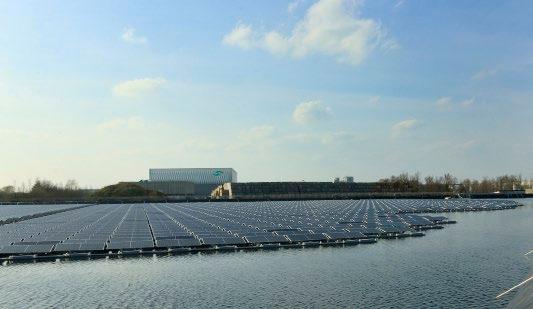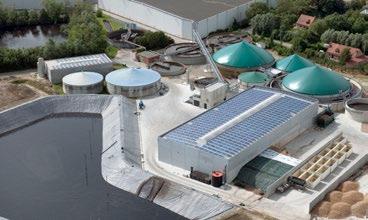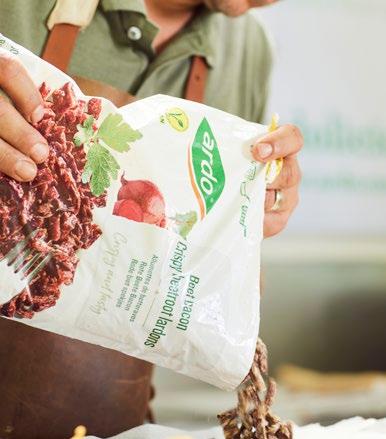
5 minute read
2. In the production phase
by Ardo
In the production phase, we have been examining our actual carbon footprint. We have been investigating how we can better manage our energy and water consumption as we use still considerable quantities of both. Our organic waste streams are also being valorised through biomethanisation and/or external channels, such as feed and composting. This is what we refer to as our circular economy approach. This approach also includes our packaging activities.
Carbon footprint
We contribute to a more stable climate for future generations by creating real surplus value for all stakeholders in the supply chain. To achieve this, we need an estimate of our climate impact. For this reason, we have calculated our carbon footprint since 2019.
According to the Greenhouse Gas Protocol, the CO2eq emissions of a carbon footprint are classified into three categories:
Scope 1 includes all direct emissions from the Ardo processing plants in Europe. As a result, natural gas combustion is the primary source of scope 1 emissions. These CO2eq emissions are also caused by the fuel combustion in the vehicles of the company fleet.
In scope 2, we calculate the indirect CO2eq emissions from the electricity and heat we purchase in Europe.
In scope 3, we plan to calculate the indirect CO2eq emissions from sources throughout the supply chain. This information is not included in this report, given the lack of standardised methods for determining CO2eq in agriculture at this point.
Sustainable Performance Targets
Energy and carbon reduction
Ardo’s goal 2030 vs. baseline 2019
-16%
-40%
Ardo is committed to take significant steps in further reducing our carbon footprint. Through investments in more solar panels, biomethanisation and energy recuperation and by continuously improving our energy efficiencies in manufacturing and (cold)storage. We are confident to achieve even higher future goals by a combination of multiple actions and programmes in our operations. In 2022 Ardo has decided to reset and increase our future goal with the objective to achieve 40% reduction of our carbon emissions per metric ton produced (TCO2eq) in scope 1-2 by 2030 compared to the base line (2019).
Ardo’s approach to circular economy
Ardo is deeply committed to becoming more energy efficient. We closely monitor our energy consumption and invest continuously in the most energy-efficient plant and equipment to ensure we use as little energy as possible. We optimise energy recuperation to produce heat from cold and cold from heat, and we invest in our own green energy production to utilise all of our resources and by-products. In addition, we set high standards for the water we use in our production processes. Water is a valuable resource that we recycle and reuse whenever possible.
While examining every stage of our operations, we identified enormous ‘green potentials’ just waiting to be tapped from within the flows of our processes. We have started with the low-hanging fruit, investing in resource conservation and developing our own circular economy. The various process flows are depicted in this diagram and are explained with specific examples from our Ardooie factory in Belgium.
Reusing our natural resources
Producing fresh frozen products requires the use of a variety of natural resources, including freshly harvested vegetables, fruit and herbs, as well as water and energy. Our resources are extremely valuable, which is why we strive to use them in the most sustainable and circular manner possible:
Valorisation of heat and cold
Once harvested, our vegetables, fruit and herbs are freshly frozen and stored at our production plants before being delivered to our customers. Creating such cold temperatures inevitably generates residual heat, which we capture and reuse to heat our offices and make hot cleaning water. When the weather is hot, we recycle the cold from the floor heating of our cold stores to keep our employees cool.
Valorisation of energy
In our anaerobic digestion plant, the biomethanisation process converts vegetable residues into biogas. This powers generators that convert the gas into green energy, both electricity and steam. Our green electricity, which is supplemented by electricity generated by a raft of solar panels floating on our irrigation reservoir, is used to freeze and store our vegetables. Meanwhile, the green steam is used to steam peel and blanch vegetables. These methods meet up to 40% of the energy needs of the Ardooie plant.
The valorisation of biomethanisation by-products
By-products are converted into organic fertiliser, which is used by our farmers to grow crops for the following season.
The re-use of water
We try to minimise our consumption of water and maximise our re-use in each production step. Water used in vegetable processing is collected and purified in our biological wastewater treatment plant. The purified water is then used again to wash the vegetables brought in from the fields. The remaining water is stored in a massive 150 million litre reservoir, which 45 local farmers can use to irrigate their crops via 150 hydrants.
Other examples from our Ardooie site
New office building
Our new headquarters was built using ‘almost energy neutral’ principles. That is, it consumes very little energy and only uses energy derived from renewable sources. There is more information on this in chapter 4
New machinery room to generate cold energy

At our Ardooie site, a brand-new machinery room has been built, designed to the most recent state-of-the-art cold production principles and optimising the working environment for our technicians. The residual heat is used to make warm water, reducing our reliance on gas or other combustibles.
While the projects described are from the Ardooie site, the same principles are followed throughout the Ardo group. There are numerous examples of sustainably driven investments and activities at other factories.
Managing packaging materials
Reducing packaging film thickness
Ardo has developed close relationships with major key players in the supply chain of plastic granulates and packaging materials since 2019. A close collaboration and the introduction of new materials resulted in new formulations for our PE (polyethylene) packaging film. Because of this, we were able to significantly reduce film thickness while maintaining strength and appearance.
By the end of fiscal year 2021-2022, the average micron had been reduced from 50 to 42 (-16%). By 2025, we aim to have achieved a similar average micron reduction for 75% of our PE film.
Replacing non-recyclable packaging

All of Ardo’s paper-based packaging has been 100% recyclable since 2019. We see an increase in customer interest with the first customers switching to 100% paper bas, after a successful trial was conducted.
By the end of fiscal year 2021-2022, approximately 60% of the total volume of foil packaging used to pack our frozen products was made from a single (mono) base plastic, such as PE (polyethylene) or LDPE (low density polyethylene). Because they are made of a single type of plastic, mono foils are recyclable.
40% of the plastic foils are laminates made from two base films to ensure the packaging’s functionality. If the laminate is made from two different types of plastic, the packaging material is more difficult to recycle. Since 2020, we have reduced the share of non-recyclable laminates by 40% by switching to recyclable laminates or mono films. Simultaneously, we have increased the proportion of recyclable laminates by 25%.
Our goal is to convert 80% of non-recyclable foils to recyclable mono foils or single film recyclable laminates.
The transition from white to brown cartons began at the start of 2020. By the end of fiscal year 2021-2022, roughly 70% of all corrugated cartons were made from brown recycled material. We managed to convert to 100% of all cartons in Ardooie, Geer, Koolskamp (Belgium), and Zundert (the Netherlands) to brown material. Other Ardo sites have already seen a significant shift from white to brown. By 2025, we aim to have converted 80% of our corrugated cartons to brown, with only specific customised packaging solutions remaining in white.
This eliminates the need for treatments to whiten the cartons, as well as the introduction of additional chemicals. It also allows for a reduction in the thickness of the papers used for corrugated cartons, as whitening reduces the strength of the paper and thus requires thicker materials.




